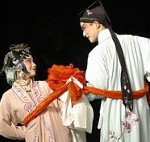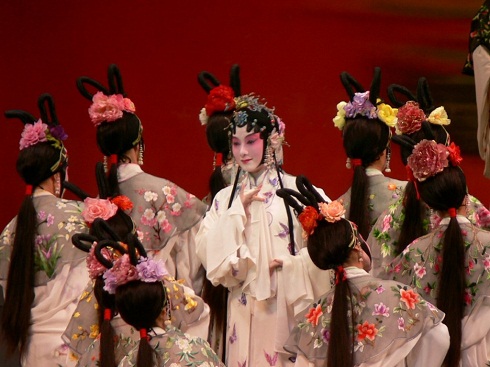The India debut of the famous Chinese Kunqu Opera will mark the close of the official Year of Friendship in 2014 for India and China. It is a fitting end to a year when the two oldest civilizations of Asia renewed an informal process of understanding each other. And when the credits roll out, acknowledgement must be given to the individual citizens and the private sector which have made the effort to create the necessary cultural awareness between India and China.
One of these efforts is the performance on 9 December, 2014, of the famous Chinese Kunqu Opera play – the Peony Pavilion – in Mumbai and Delhi, brought to India as part of the annual Sadir Theatre Festival and Bravia Capital, a global private investment firm with offices in both India and China.
Kunqu stands beside our own Kathakali and Bharata Natyam, among the world’s oldest art forms and performed for centuries. The Peony Pavilion, a love story, was first performed in 1598, and was written by one of China’s preeminent play writers, Tang Xianzu.
To get a better understanding of the Kunqu Opera, and what it means in the context of India-China relations, Gateway House’s Saumya Pant and Dev Lewis interviewed Swati Bhise, the artistic director of Sadir Theatre Festival and a renowned Bharat Natyam dancer, and France’s Consul-General in Mumbai, Jean-Raphael Peytregnut, a China expert and cultural who has translated the Peony Pavilion play from Chinese to French.
Q: Tell us about the Kunqu Opera and the Peony Pavilion. Why is it so special?
Swati Bhise:
Kunqu Opera is one of the most refined art forms in China and the world—combing drama, poetry, music, dance, and ballet, it draws from many facets of life to create a high level of entertainment. In 2001 it was listed as one of the UNESCO masterpieces of oral and Intangible Heritage of Humanity.
The Peony Pavilion in particular is one of the most famous operas, written by Tang Xianzu, one of China’s most celebrated play writers.
CG Peytregnut:
The Kunqu Opera is a type of Chinese classical opera and the Peony Pavilion is one of the most famous plays. Kunqu is recognized as one of the most difficult and evolved forms of Chinese theatre. The plays are written in classical Chinese by scholars. The language is so difficult that only Mandarin speakers who have received special education in classical Chinese are able to understand it.
However, even if you don’t understand the language, you can appreciate the songs and the beautiful melody of flute along with the other musical instruments. The play is a romantic story of a girl who falls in love with a young scholar. It is extremely well written and aesthetically very beautiful.
The original Peony Pavilion play is very long – it takes three days to perform and consists of 55 acts. The performance that you will see in Mumbai is the part when the main character, Du Liniang, falls asleep in her parents’ garden and starts dreaming about the young scholar that she is in love with.
Q: Can you elaborate on the historical and cultural context of the play?
CG Peytregnut:
The play was written by Tang Xianzu, a scholar and mandarin, who is one of the most famous play-writers in China. His status is similar to Shakespeare’s. Coincidentally, both Tang and Shakespeare, along with Spanish playwriter Miguel De Cervantes, died in the same year—1616.
The Peony Pavilion was written and first performed around the end of the Ming dynasty when the authorities were very corrupt. This was the time of invasions from foreign forces mostly because the reigning emperor was not strong enough.
Taoism was a very popular religion at the time, as was Confucianism. At the time there were many religious superstitions, one had to obey rules, and individualism was not tolerated.
Tang opposed these stifling rules and through the play he tried to stress on the importance of individual freedom and expression, and how having a personality is the only way to express the truth inside you.
The Peony Pavilion is one of four pieces written by him. His pieces are commonly referred to as the ‘four dreams’, because each play is set in the context of a dream. In this play the girl expresses her love for a man, even has sexual relations with him. This caused quite a scandal.
Q: Historically speaking, what was the role of opera in Chinese culture?
CG Peytregnut:
There were many kinds of plays with different purposes.
There were plays for the ‘common people’ which were performed during festivals. These performances often took place in temples. For example, if you visit old temples in Southern China today you will notice that there are always platforms for actors.
The rich families, the scholars, they would host small theatres in their house, invite some friends during the weekend to enjoy a play while they drank tea and ate meals.
Plays often had a political purpose, which was to criticise the authorities at the time. The main theme of the Peony Pavilion is about love but there are a number of smaller stories within the play through which the author could talk about contemporary life.
Q: Do you think debut of the Kunqu Opera in India can help bridge the cultural deficit between the two countries?
Swati Bhise:
In my experience as a Bharata Natyam performer, around the world I have found that the artists can speak to another culture with far greater honesty than say politicians or businessmen—who often come with political or personal agendas. Culture is the doorway from one country to the other.
The Peony Pavilion show is one of China’s great heritages. It can be a great cultural connect between Indians and Chinese. It can be a starting conversation point for Indian businessmen when they travel to China.
When India started doing business with the U.K., people connected by talking about Shakespeare etc. If we can do that, why can’t we appreciate Chinese culture, especially when there are so many similarities between the two cultures?
CG Peytregnut:
Generally speaking I think the exchange of people and culture is a good way to get two countries closer together. China is India’s neighbour and in the long history between the two countries, there have been a lot of exchanges. I think India has had more influence in China than vice-versa. Buddhism came from India and in the past Buddhist priests from China travelled to India to collect Buddhist scriptures and translate them into Chinese.
Q. How do you compare and contrast forms of Indian classical dance with Kunqu?
Swati Bhise:
There are a host of similarities between Kunqu and forms of Indian classical dance such as Bharat Natyam, Kathakali.
For one, both are ancient art forms and their styles have been passed from one generation to another. Both are built on the medium of oral teaching traditions that are passed down from one guru to a shishya or in China, a master who teaches his disciple the rules.
Both art forms are extremely refined, requiring a sophisticated understanding of literature, rules and studies. For example, both have stylised hand gestures which are always in sync with the percussion and music.
Then there is also the political and historic context—both Kunqu and Bharata Natyam have a shared history of being suppressed and impacted by the changing political climate. Starting from the early 1900s, Kunqu almost disappeared as China went through a series of political upheavals. In fact, it was not until the end of the Cultural Revolution in 1976 that Kunqu was revived. Likewise in British India, Bharata Natyam was banned and it took a tremendous effort after 1947 for the art from to be revived.
Q: Why is it important for a city like Mumbai to host the Kunqu Opera? How important is the role of the private sector in bolstering the relationship?
Swati Bhise:
Here in India we view our country as a world power, home to many languages. If we are truly interested in globalization, it is important to be aware of other countries and their cultures.
Why is New York City considered to be one of the most globalised cities in the world? One of the reasons is because the private sector there promotes the arts in every form, through patronage, funding exhibitions on various countries.
Globally, it is the private sector that always promotes the arts. Art institutes are private ventures, through which their communities can develop an awareness of the world around them, and create linkages between countries which form the platform for improved economic relations.
Q: How did France approach the issue of negative perception? Did the private sector play a role?
CG Peytregnut:
Yes, the private sector plays an important role. In fact, the cultural events currently taking place in France and China to commemorate the 50th anniversary of diplomatic relations between France and China are mainly sponsored by private companies—both French and Chinese. They (the companies) have an interest in developing a strong relationship, if they (French) companies want a bigger share in the Chinese market, they have to involve themselves in activities such as these.
France and China have a strategic partnership. We established diplomatic relations with China in 1964, and we are hosting a number of cultural events in both France and even in India to celebrate 50 years of France-China friendship. Many Chinese students will come to France and vice-versa to study.
Q: What is China’s approach to soft power? How important is it to understand Chinese culture?
CG Peytregnut:
Earlier China did not attach too much importance to soft power but this has changed in the past couple of years. You can see this through their expansion of the Confucius Institutes around the world, just like the U.K. did through the British Council and the French through the Alliance Francaise. Through these institutes the Chinese government is trying to educate foreigners about China. Because China’s culture and civilisation are so unique, it needs to be explained to people. If you do not speak the language or have direct access to the culture, you will not understand the country. I often say if you read the articles about China written by the French press, and then travel to China, you will not recognise the country.
Saumya Pant is Senior Content Manager at Gateway House
Dev Lewis is Digital Media Associate at Gateway House
This blog was exclusively written for Gateway House: Indian Council on Global Relations. You can read more exclusive content here.
For interview requests with the author, or for permission to republish, please contact outreach@gatewayhouse.in.
© Copyright 2014 Gateway House: Indian Council on Global Relations. All rights reserved. Any unauthorized copying or reproduction is strictly prohibited



